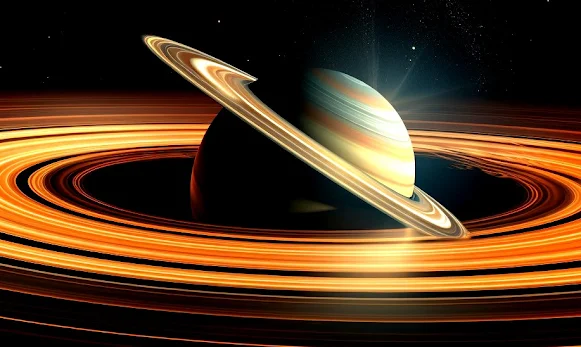In about eighteen months, Saturn's magnificent rings will vanish.
The amazing rings of Saturn were originally observed by
Galileo Galilei, who is recognized as the father of modern astronomy, in 1610.
Based on his preliminary views with an antiquated telescope, he described these
celestial features as having the appearance of "ears."
Even with simple astronomy equipment, anyone can now, millennia later, explore the wonders of Saturn's rings.cosmic occurrence However,
the spectacle will only last until 2025, at which point Saturn's rings will
disappear from view twice. This cosmic phenomenon, which consists of seven
separate rings, is thought to have originated from comet, asteroid, and moon
fragments that were drawn too close to Saturn and shattered by the planet's
strong gravitational attraction.
In addition, the rings are covered in a coating of cosmic dust and host innumerable icy pieces.
Their exact age is still up for discussion, but a new study suggests they might
be very young stars, having formed perhaps only 400 million years ago, which
would make them younger than a tenth of Saturn's age.
invisible bands Currently, scientists are aware that Saturn's rings are gradually receding and breaking up
into a hail of frozen fragments that enter the planet's atmosphere.
When Saturn passes directly in front of Earth in 2025, its magnificent rings will be almost
completely obscured. This is like attempting to find a piece of paper at the
far end of a soccer field with its edge facing up.
Transient occurrence.
But this show is really a transient cosmic phenomenon. Saturn will progressively tilt during its
29.5-year orbital dance, revealing its ring system's other side until it
reaches a peak display in 2032. The improved visibility of Saturn's moons is a
benefit of this celestial tilt.
For now, Saturn provides a great vantage point for astronomy at night. So while you still have
the chance, take advantage of the grandeur of Saturn's rings by using a
telescope to view them. Additional information about Saturn
The second-largest planet in the solar system, after Jupiter, is Saturn, which is located six
planets from the Sun. Helium and hydrogen make up the majority of Saturn's
composition. Even though it is only roughly 95 times more massive than Earth
and has a low density, it has a radius that is roughly nine times that of Earth.
Handles
Numerous tiny particles that orbit the planet, ranging in size from micrometers to meters,
make up Saturn's ring system. With a minor quantity of dust and rocky debris,
the majority of these particles are composed of ice. The
other rings are called alphabetically in the order in which they were found.
The moons
Titan is the largest moon in the Solar System and the second largest after Jupiter's
Ganymede, out of at least 145 moons orbiting the planet. Titan, which is bigger
than Mercury, is the only moon that is known to have a significant atmosphere,
mainly composed of nitrogen with small amounts of methane.
Field of magnetic attraction
Although Saturn's magnetic field is not as strong as Jupiter's, it is still many times greater
than Earth's. Additionally, radio waves are released by Saturn, especially from
its pole-based auroras.
Huygens-Cassini expedition
From the time of its arrival at Saturn in 2004 until its mission's conclusion in 2017 by delving
into Saturn's atmosphere, the Cassini-Huygens mission—a collaborative effort
between NASA, the European Space Agency, and the Italian Space Agency—provided
a wealth of information about Saturn, its rings, and its moons.
Traditions
Saturn was named for the Roman god of agriculture and prosperity, who was also Jupiter's
mythological father. Since ancient times, this planet has been noticed, and its
astronomical sign (♄) has been associated with the god's sickle.
Rings of Saturn Among the most
remarkable and unique characteristics of any planet in our solar system are
Saturn's rings. Here are some important details regarding them:
Make-Up
With a lesser amount of dust and rocky debris, the rings are mostly made up of ice particles.
The ice fragments can vary in size, from little grains to massive blocks the
size of buildings.
Framework Countless tiny
particles in orbit around Saturn make up the rings, which are not solid. Their
typical thickness is approximately 10 meters, despite their extreme thinness
and enormous width (up to 282,000 km in diameter).
Split Up With differing transparency and brightness, the rings are separated into multiple sections called the A, B, C, D, E, F, and G rings. The most noticeable and
straightforward to see are the A, B, and C rings.
Deficits
The rings contain several gaps, such as the Cassini Division, a 4,800-kilometer-wide area that
divides the A ring from the B ring. The Keeler Gap and the Encke Gap are two
other noteworthy gaps.
Movements The gravitational interactions between Saturn's moons and the rings' structure and patterns are referred to as "orbital resonances." Known as "shepherd
moons," certain moons orbit close to the rings' edges, assisting in
maintaining the rings' crisp edges and alignment.
Start
Regarding the genesis of the rings, there are various ideas. Some speculate that they are
comet or moon debris left over from a collision. An alternative theory suggests
that they are remnants of the primordial nebular matter that gave rise to
Saturn. The rings are thought to be quite young, maybe a few hundred million
years old, though their exact age is still up for debate.

